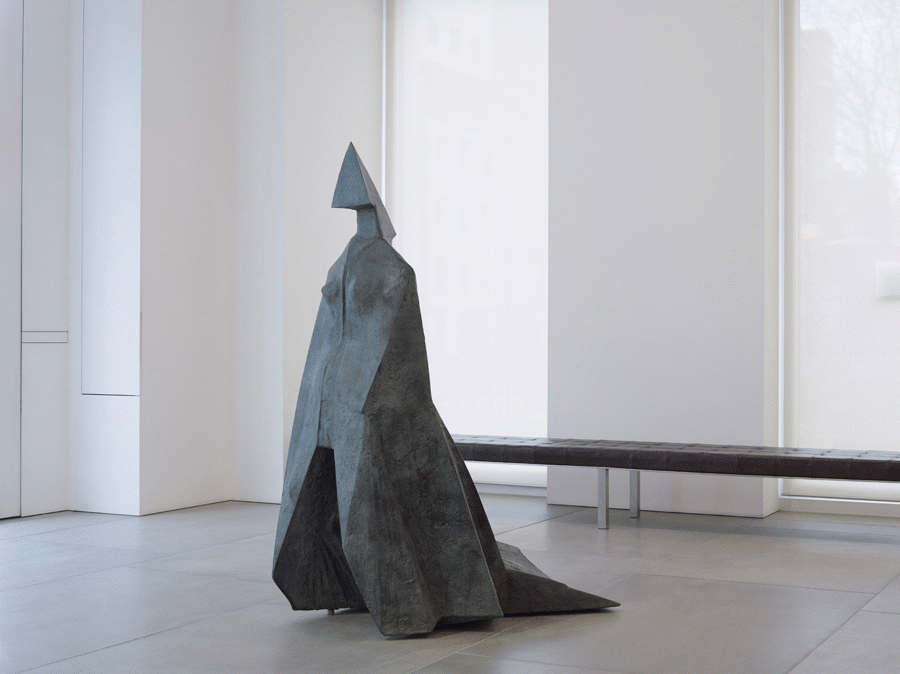Blain/Southern, London, 24 November – 21 January 2017
The pure present is an ungraspable advance of the past devouring the future. In truth, all sensation is already memory.’ So wrote Henri Bergson in Matter and Memory (1896); 120 years later, those words seem a fitting description of Revolt of the Sage. Featuring 16 artists’ works, from 1956 to 2016, this exhibition takes its title from a 1916 painting by Giorgio de Chirico, in which a shallow and confined pictorial space teems with wooden frames, planar objects, measuring devices and biscuits, alongside other unidentifiable edibles, all warped by an unnerving raking perspective. In a letter to Guillaume Apollinaire, de Chirico described the painting, which is sadly not present in the exhibition, as one of his ‘metaphysical interiors’, referring to a body of work in which he endeavoured to depict two realms: that of our mortal condition (and the senses of loss and longing that that finitude inspires), and a secondary dimension in which ‘the past and future appear to us as equal [and] memory blends with prophecy in a mysterious union’. Through his peculiar marriage of everyday objects and distorted architectural spaces, de Chirico sought to create what he described as a jolt of revelation within the viewer, a dislocation between past, present and future, and between the individual subject and the space s/he inhabits.
Curated by artist Simon Moretti, who also features in the exhibition, with Craig Burnett, Blain/Southern’s director of exhibitions, the works included use collage, juxtaposition, fragmentation and layering to examine ruptures, unions and confluences in time and mortality. Looming morbidly in the exhibition foyer is Lynn Chadwick’s bronze Cloaked Figure IX (1978), appearing almost as a bad omen, while other bronze works, Monitor and Monitor III (both 1965), cast their ominous, all-seeing eyes over the main room and stairwell respectively. A gang of his smaller, maquette-like works, including Kink (1964) and Pyramid IV (1965), animate the lower gallery. Although leaning towards the abstract, Chadwick’s forms always take humanity and its history as their starting point, collapsing the distinction between figuration and abstraction: ‘I shall never neglect humanity. Even in my most abstract figure, the Pyramids, I took man as a starting point.’ Indeed Pyramid IV’s highly reflective surface somehow breaks down its own form, merging with our reflections and those of the room around us – incorporating all three with liquidlike effects.
Collages by John Stezaker, Goshka Macuga and Haris Epaminonda also recur throughout the spaces. Stezaker’s Masks and Flashes (those shown here dating from 2016 and 2007, respectively) make frequent appearances, their deceptively simple format – two images spliced together – of tunnels, bridges, woodlands, grottoes and waterfalls with the faces of film actors; or 1950s images of children playing imposed, literally, as a flash or star, over static items of furniture, create windows into or through to temporal and spatial moments. Epaminonda’s small, subtle collages also allow a particular action to appear simultaneously in different times and places. Incorporating images of antique pottery, Ancient Greek columns, plinths, niches and ruins culled from old magazines and books, Epaminonda makes minimal cuts or impositions to her images, often replacing a background or viewpoint with a foreign landscape or flat colour, accumulating myriad visual histories in one work. Meanwhile, Macuga’s Frame for Tichy 20 (2013) consists of newly printed images from Czech photographer Miroslav Tichý’s clandestine photographs of women, captured in his hometown of Kyjov from the 1960s to the mid-80s. The negatives that Macuga has chosen to print from, often double-exposing two images in one or collaging the photographs with scraps of pattern, are evidently Tichý’s rejects, so damaged that Macuga’s resultant prints appear to flicker before your eyes, like a VCR on pause.
Elsewhere, two sets of Sigmar Polke’s manipulated photocopies convey a variety of distortions, physically blurring and smearing the human form. Hanne Darboven’s collaged drawing Dostojewski, Monat Januar (1990) conflates a recorded span of time (the month of January in 1990) with her admiration for Russian writer Fyodor Dostoevsky, diagrammatising the idea of time as an abstract system, while documenting the actual time of an artist’s labour. Erin Shirreff’s photographs and large-scale cyanotype consider the semantic distance between objects and their representation, capitalising on the potential ambiguity of the objects she photographs (blank geometric forms) to create her austere yet suggestive imagery.
As with Bergson, de Chirico’s reflections on time came from his understanding of duration as ineffable and describable only through discrete images or events. Mark Lewis’s video The Night Gallery (2014) perhaps demonstrates this most strikingly. Set in the dark in the Louvre’s Sully Wing, home to medieval figurative sculpture, this silent video consists of a camera’s slow surveying of the surrounding figures while a flashlight pulses off and on, leaving only traces of a visual, as some sort of retinal memory. This seems to create a new kind of temporal space in which the paths of the eye and of memory are confused and duration is marked only by the infrequent surges of light. Although the exhibition contains works of significantly different genres and eras, they all share a common ground that acknowledges this way of understanding or creating durational shifts, and they all employ tactics such as collage, abstraction, cropping and inversion to generate or simulate a temporal jolt. Testing our ideas around memory, anachronism and repetition, the exhibition recapitulates de Chirico’s want towards the implosion of past, present and future, and leaves one feeling intrigued and absorbed, if a little anxious.
From the January & February 2017 issue of ArtReview
